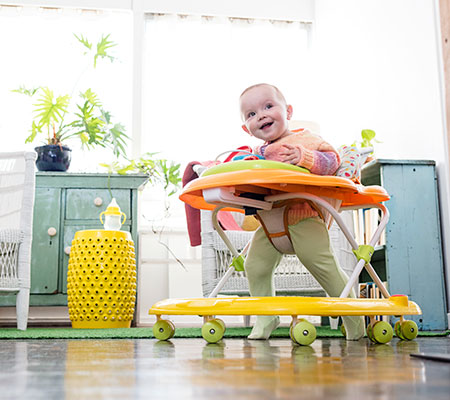
Along with delaying development, baby walkers’ mobility can lead to falling down stairs and reaching harmful objects.
The American Academy of Pediatrics (AAP) called for a ban in the early 2000’s on the manufacture and sale of baby walkers with wheels, and stated on healthychildren.org that walkers are a dangerous choice.
Dr. David Holz, Marshfield Clinic pediatrician, agrees that baby walkers should no longer be used by parents. One of his main reasons is because of stairs.
“If a baby gets to unprotected stairs and rolls down, it could be problematic, but they tend to be OK,” he said. “If they go down in a mobile walker, that event can be fatal.”
Dangers of baby walkers
Aside from the stairs, Holz said walkers permit more mobility at an age when a child isn’t supposed to be mobile. This can lead to a child reaching dangerous items, such as stove tops, breakable tableware and sharp objects. Often times, Holz said parents are not prepared for the possible items a child can reach in most cases.
“There’s not really any benefit to putting a baby in a walker,” he said. “It doesn’t make them walk sooner, or help them developmentally in anyway to be able to move around. There’s no benefit to go with that potential very serious risk.”
Despite the myth that baby walkers help your child walk, Holz says we have to learn to crawl before we can walk. A child isn’t meant to be moving around on their legs at that age. He said it may be fun for parents to see their child move around freely, but children need to learn coordination, especially through their core.
Because the baby walker supports them artificially, it doesn’t allow a natural progression from rolling to creeping to crawling to walking,” Holz said. “It doesn’t allow them to work on their core coordination.”
Alternatives for children
Parents can now purchase non-wheeled devices like exersaucers, which limit mobility, for their child to use and stand up. However, Holz said even with those the amount of time in use should be limited to 10-15 minutes.
“Just floor time is best,” he said. “We don’t necessarily need a device to help with development. Have them positioned on the floor in safe space so that they’re able to interact with toys and move around in a natural developmental stage progression.”
Jumpers also are fine to use for babies, but they do not provide any developmental benefit, and time should be limited as well. Cruisers or wagons are another option for children to use. Similar to using a couch to stand up, this allows natural progression through developmental stages. Holz said unprotected stairs are always a precaution, but stairs are far more dangerous with walkers.
“The entire weight of the walker is going to come down on top of them,” he said. “The risk of a devastating injury is considerably less with other options.”
What if you need to leave the room?
Holz said parents can place their child in a pack-n-play, exersaucer or other protected area, if needed.
“If they have to be kept safe for a parent to walk out of the room briefly, a non-wheeled device can have them be upright and playing with their hands, but there’s no risk of the child moving around,” he said.
Talk with your child’s provider if you have questions about what’s best for crawling to walking development.
Related Shine365 posts:
Surprising choking hazards in your home
Protecting babies from germs: Tips for grandparents and guests

